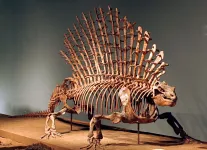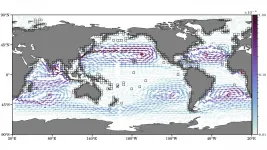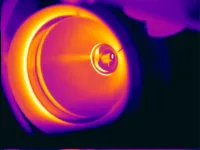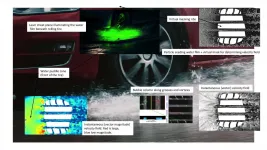Here's how insects coax plants into making galls
2021-03-02
(Press-News.org) Insects can reprogram plant growth, transforming ordinary plant parts into intricately patterned shelters that are safe havens for feeding and reproduction.
These structures, called galls, have fascinated biologists for centuries. They're crafted by a variety of insects, including some species of aphids, mites, and wasps. And they take on innumerable forms, each specific in shape and size to the insect species that's created it - from knobs to cone-shaped protrusions to long, thin spikes. Some even resemble flowers.
Insects create galls by manipulating the development of plants, but figuring out exactly how they perform this feat "feels like one of the great unsolved problems in biology," says David Stern, a group leader at the Howard Hughes Medical Institute's Janelia Research Campus. "How does an organism of one kingdom take control of the genome of an organism in another kingdom to completely reorganize its development, to produce a home for itself?"
Now, Stern and his colleagues have identified the first examples of insect genes that directly guide gall development. These genes are turned on in aphids' salivary glands and appear to direct gall formation when the insects spit their saliva into the plants. One gene the team identified determines whether such galls will be red or green, the researchers report in a paper published March 2 in Current Biology.
"I think they've discovered essentially new territory," says Patrick Abbot, a molecular ecologist at Vanderbilt University who wasn't involved in the work. There's a strong likelihood that similar genes are found in other insects, he says. "It makes me want to run to the lab and start looking back through my data."
Figuring out how to study gall formation has been a longstanding challenge, Stern says - one that's interested him since he was a graduate student doing fieldwork in Malaysia. Gall-making insects aren't laboratory model organisms like fruit flies, and not as much is known about their genetics.
A few years ago, while wandering the woods of Janelia's riverside campus, Stern made a convenient observation. Hormaphis cornu aphids make galls on witch hazel trees, small flowering trees that are abundant on campus. Even on a single leaf, Stern noticed, some Hormaphis aphids were making green galls, while others were making red ones. It set up a natural experiment - a chance to compare two visibly distinct kinds of galls and figure out what's genetically different between the aphids that make them.
When Stern and his team sequenced the genomes of aphids that made green galls and those that made red galls, they pinpointed a gene that varied between the two genomes. Aphids with one version of a gene that they named "determinant of gall color" made green galls; aphids with a different version made red ones. The finding piqued their curiosity, as the gene didn't look like any previously identified genes.
To dive deeper, they collected aphids from both witch hazel trees and river birch trees. (Hormaphis cornu aphids live on river birch trees in the summer, but don't make galls there.) Back in the lab, the researchers carefully dissected out the insects' tiny salivary glands. In these glands, the team hunted for genes that were turned on only in the aphids that made galls. The researchers found that the gene determinant of gall color was similar to hundreds of other genes that were all turned on specifically in the gall forming aphids. Stern's team dubbed this group bicycle genes.
The gall-making aphids on the witch hazel trees switch on these genes to make BICYCLE proteins. The insects might spit these proteins into plant cells to reprogram leaf tissue into making a gall instead of normal plant parts, says Aishwarya Korgaonkar, a research scientist in the Stern lab who helped lead the project.
The team is now working to identify the plant molecules targeted by the aphids' BICYCLE proteins, says Korgaonkar. That could help them understand just how BICYCLE proteins goad plants into forming galls.
"After years of wondering what's going on, it's very rewarding to have something to show for it," Stern says.
INFORMATION:
Citation
Aishwarya Korgaonkar, Clair Han, Andrew L. Lemire, Igor Siwanowicz, Djawed Bennouna, Rachel Kopec, Peter Andolfatto, Shuji Shigenobu, and David L. Stern. "A novel family of secreted insect proteins linked to plant gall development." Current Biology. Published online March 2, 2021. Doi: 10.1016/j.cub.2021.01.104
[Attachments] See images for this press release:
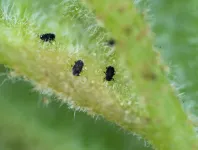
ELSE PRESS RELEASES FROM THIS DATE:
2021-03-02
The backbone is the Swiss Army Knife of mammal locomotion. It can function in all sorts of ways that allows living mammals to have remarkable diversity in their movements. They can run, swim, climb and fly all due, in part, to the extensive reorganization of their vertebral column, which occurred over roughly 320 million years of evolution.
Open any anatomy textbook and you'll find the long-standing hypothesis that the evolution of the mammal backbone, which is uniquely capable of sagittal (up and down) movements, evolved from a backbone that functioned ...
2021-03-02
WASHINGTON, March 2, 2021 -- Tons of plastic debris get released into the ocean every day, and most of it accumulates within the middle of garbage patches, which tend to float on the oceans' surface in the center of each of their regions. The most infamous one, known as the Great Pacific Garbage Patch, is in the North Pacific Ocean.
Researchers in the U.S. and Germany decided to explore which pathways transport debris from the coasts to the middle of the oceans, as well as the relative strengths of different subtropical gyres in the oceans and how they influence long-term accumulation of debris.
In Chaos, from AIP Publishing, Philippe Miron, Francisco Beron-Vera, Luzie Helfmann, and Peter Koltai report creating a Markov chain ...
2021-03-02
What The Study Did: This study investigates emergency department visits for violence-related injuries occurring at home and outside the home in Cardiff, Wales, before and after COVID-19 lockdown measures were instituted in March 2020.
Authors: Jonathan P. Shepherd, Ph.D., Crime and Security Research Institute at Cardiff University in Wales, is the corresponding author.
To access the embargoed study: Visit our For The Media website at this link https://media.jamanetwork.com/
(doi:10.1001/jama.2020.25511)
Editor's Note: Please see the article for additional information, including other authors, author contributions ...
2021-03-02
In a mouse study, Australian researchers have mapped out what happens behind the scenes in fat tissue during intermittent fasting, showing that it triggers a cascade of dramatic changes, depending on the type of fat deposits and where they are located around the body.
Using state-of-the-art instruments, University of Sydney researchers discovered that fat around the stomach, which can accumulate into a 'protruding tummy' in humans, was found to go into 'preservation mode', adapting over time and becoming more resistant to weight loss.
The findings are published today in Cell Reports.
A research team led by Dr Mark Larance examined fat tissue types from different locations to understand their role during every-other-day fasting, ...
2021-03-02
The first UK COVID-19 lockdown saw a "rapid and sustained" fall in violence outside the home in the Welsh capital city, a new study led by Cardiff University has shown.
Researchers from Cardiff University's Crime and Security Research Institute (CSRI) and the US Centers for Disease Control and Prevention studied data from Cardiff's sole emergency department (ED) from March to June 2020 and compared it to weekly data from January 2019 onwards.
They found there were almost 60% fewer attendances per week for violent injury outside the home in the first lockdown during ...
2021-03-02
WASHINGTON, March 2, 2021 -- When a vehicle travels over a wet or flooded road, water builds up in front of the tire and generates a lift force. In a phenomenon known as hydroplaning, this force can become large enough to lift the vehicle off the ground.
In Physics of Fluids, by AIP Publishing, scientists from the CNRS, the University of Lyon, and The Michelin Group use a laser imaging technique to study water flow in front of and through tire grooves.
To counteract hydroplaning, tread designs are chosen to drain water from the front of the tire without decreasing its ability to adhere to the road. Very few quantitative experimental studies of the movement of water through tire grooves have been done, so little is known about the exact flow patterns in ...
2021-03-02
What The Study Did: This study suggests that, during the COVID-19 pandemic, a hotel- based isolation and quarantine strategy that delivers integrated medical and behavioral health support to people experiencing homelessness can be done safely outside the hospital setting.
Authors: Jonathan D. Fuchs, M.D., M.P.H., of the San Francisco Department of Public Health, is the corresponding author.
To access the embargoed study: Visit our For The Media website at this link https://media.jamanetwork.com/
(doi:10.1001/jamanetworkopen.2021.0490)
Editor's Note: The article includes conflict of interest and funding/support disclosures. Please see the article for additional information, including other authors, author contributions and affiliations, conflict of interest ...
2021-03-02
What The Study Did: Wearing surgical face masks for 30 minutes was not associated with changes in respiratory parameters or clinical signs of respiratory distress in this study of 47 infants and young children in Italy.
Authors: Silvia Bloise, M.D., of Sapienza University of Rome in Italy, is the corresponding author.
To access the embargoed study: Visit our For The Media website at this link https://media.jamanetwork.com/
(doi:10.1001/jamanetworkopen.2021.0414)
Editor's Note: Please see the article for additional information, including other authors, author contributions and ...
2021-03-02
The Medicare Part D program would have saved $977 million in a single year if all branded prescription drugs requested by prescribing clinicians had been substituted by a generic option, according to a new study by researchers at the Johns Hopkins Bloomberg School of Public Health. And if Medicare patients had requested generic drugs instead of brand name drugs, the Medicare Part D program would have saved an additional $673 million in one year, for a total savings of $1.7 billion.
Medicare Part D offers supplemental outpatient drug coverage plans for seniors ...
2021-03-02
WASHINGTON, March 2, 2021 -- Cardiovascular disease remains the number one cause of death globally. Unfortunately, the heart cannot regenerate new tissue, because the cardiomyocytes, or heart muscle cells, do not divide after birth.
In their paper, published in APL Bioengineering by AIP Publishing, Syracuse researchers developed a shape memory polymer to grow cardiomyocytes. Raising the material's temperature from 30 degrees Celsius to 37 degrees Celsius turned the polymer's flat surface into nanowrinkles, which promoted cardiomyocyte alignment.
The research is part of the growing field of mechanobiology, which investigates how physical forces between cells and changes ...
LAST 30 PRESS RELEASES:
[Press-News.org] Here's how insects coax plants into making galls

